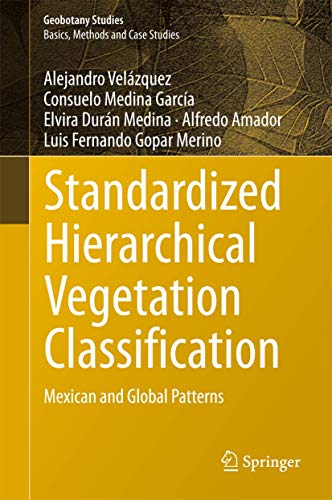Artículos relacionados a Standardized Hierarchical Vegetation Classification:...
Standardized Hierarchical Vegetation Classification: Mexican and Global Patterns (Geobotany Studies) - Tapa dura

"Sinopsis" puede pertenecer a otra edición de este libro.
"Sobre este título" puede pertenecer a otra edición de este libro.
- EditorialSpringer
- Año de publicación2016
- ISBN 10 3319412213
- ISBN 13 9783319412214
- EncuadernaciónTapa dura
- Número de edición1
- Número de páginas168
Comprar nuevo
Ver este artículo
Gastos de envío:
GRATIS
A Estados Unidos de America
Los mejores resultados en AbeBooks
Standardized Hierarchical Vegetation Classification: Mexican and Global Patterns (Geobotany Studies) by Velázquez, Alejandro, Medina GarcÃa, Consuelo, Durán Medina, Elvira, Amador, Alfredo, Gopar Merino, Luis Fernando [Hardcover ]
Descripción Hardcover. Condición: new. Nº de ref. del artículo: 9783319412214
Standardized Hierarchical Vegetation Classification: Mexican and Global Patterns (Geobotany Studies)
Descripción Condición: New. Nº de ref. del artículo: ABLIING23Mar3113020097295
Standardized Hierarchical Vegetation Classification : Mexican and Global Patterns
Descripción Condición: New. PRINT ON DEMAND Book; New; Fast Shipping from the UK. No. book. Nº de ref. del artículo: ria9783319412214_lsuk
Standardized Hierarchical Vegetation Classification
Descripción Buch. Condición: Neu. This item is printed on demand - it takes 3-4 days longer - Neuware -This book outlines the transitions between cultured and natural land cover/vegetation types and their implications in the search for alternatives to reverse the trend of anthropogenic environmental degradation. It also elaborates on the proposed 'standardized hierarchical Mexican vegetation classification system' and geobotanical mapping, a critical transversal environmental issue. The first chapter consists of an historical review of the common approaches to the study of vegetation both in Mexico and in other regions of the world. The second chapter concisely analyzes the existing schools of thought that have led to the development of vegetation classification systems based on physiognomic, structural and floristic approaches. The focal point of the book is the 'standardized hierarchical Mexican vegetation classification system' (SECLAVEMEX - 'Sistema jerárquico estandarizado para la clasificación de la vegetación de México'). Chapter 3 describes the system's organizational levels along with the criteria defining them and the nomenclatural basis for the denomination of each type of vegetation. It also includes a series of tables explaining and precisely defining the meaning of each concept, criterion, character and element used to help readers successfully identify the type of vegetation in a determined area. The fourth chapter highlights SECLAVEMEX's inclusive character as evidenced through its compatibility with other systems currently used around the globe. Three concepts are critically reviewed: land cover, land use and vegetation. These are often the study subject of the contrasting disciplines geography, agronomy and ecology, which all rely upon plant species assemblages. As such, the final chapter focuses on a critical transversal environmental issue - geobotanical mapping. Geobotanical mapping offers a baseline for land cover/use planning and provides critical information on ecological, economic and cultural attributes, which can be used as a basis for environmental-policy decisions. The proposed SECLAVEMEX was applied to Mexico as an example of land cover, land use and vegetation patterns intermingling as the result of a long human influence. SECLAVEMEX, however, can be adapted and hopefully adopted globally as a baseline for consistently comparing geobotanical patterns and their transitions. 168 pp. Englisch. Nº de ref. del artículo: 9783319412214
Standardized Hierarchical Vegetation Classification
Descripción Condición: New. Dieser Artikel ist ein Print on Demand Artikel und wird nach Ihrer Bestellung fuer Sie gedruckt. Presents a framework for combining land cover, land use, and vegetation for mapping purposesOffers an innovative geobotanical classification system, suitable for use around the globe Provides access to high-quality geobotanical. Nº de ref. del artículo: 121579760
Standardized Hierarchical Vegetation Classification : Mexican and Global Patterns
Descripción Buch. Condición: Neu. Druck auf Anfrage Neuware - Printed after ordering - This book outlines the transitions between cultured and natural land cover/vegetation types and their implications in the search for alternatives to reverse the trend of anthropogenic environmental degradation. It also elaborates on the proposed 'standardized hierarchical Mexican vegetation classification system' and geobotanical mapping, a critical transversal environmental issue. The first chapter consists of an historical review of the common approaches to the study of vegetation both in Mexico and in other regions of the world. The second chapter concisely analyzes the existing schools of thought that have led to the development of vegetation classification systems based on physiognomic, structural and floristic approaches. The focal point of the book is the 'standardized hierarchical Mexican vegetation classification system' (SECLAVEMEX - 'Sistema jerárquico estandarizado para la clasificación de la vegetación de México'). Chapter 3 describes the system's organizational levels along with the criteria defining them and the nomenclatural basis for the denomination of each type of vegetation. It also includes a series of tables explaining and precisely defining the meaning of each concept, criterion, character and element used to help readers successfully identify the type of vegetation in a determined area. The fourth chapter highlights SECLAVEMEX's inclusive character as evidenced through its compatibility with other systems currently used around the globe. Three concepts are critically reviewed: land cover, land use and vegetation. These are often the study subject of the contrasting disciplines geography, agronomy and ecology, which all rely upon plant species assemblages. As such, the final chapter focuses on a critical transversal environmental issue - geobotanical mapping. Geobotanical mapping offers a baseline for land cover/use planning and provides critical information on ecological, economic and cultural attributes, which can be used as a basis for environmental-policy decisions. The proposed SECLAVEMEX was applied to Mexico as an example of land cover, land use and vegetation patterns intermingling as the result of a long human influence. SECLAVEMEX, however, can be adapted and hopefully adopted globally as a baseline for consistently comparing geobotanical patterns and their transitions. Nº de ref. del artículo: 9783319412214

